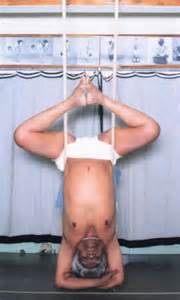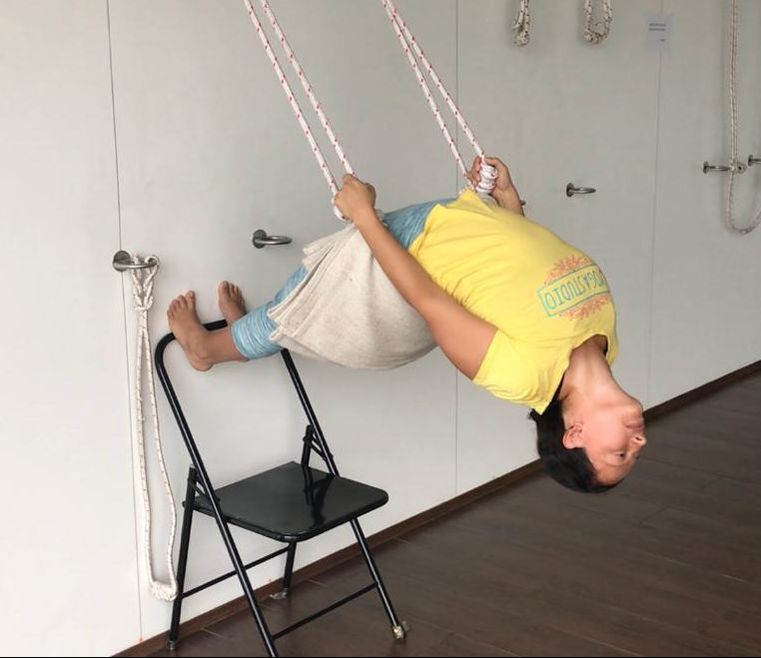50 HOUR yoga kurunta
imersion program
|
Yoga Kurunta (Koronta, or also known as Yoga Rope Wall) is a practice that was initially introduced by T. Krishnamacharya in his yoga shala in Mysore, Karnataka, India. The initial postures were published in the book Yoga Makaranda. Later on, BKS Iyengar, having been inspired by his Guru Kirhsnamacharya, developed a deeper practice on yoga Kurunta in Pune.
Iyengar in his later years, used Yoga Kurunta as a therapeutic, strengthening and alignment tool. In her book “Yoga - A Gem for Women”, Gheeta Iyengar gives a thorough explanation of the first yoga Kurunta postures ever taught to women. Yoga Kurunta aims to allow the body to be suspended as well as supported and be able to create different postures without injury. It is a practice were we use ropes which have been attached to a wall and they allow freedom of movement, stability, flexibility and body awareness. |
COURSE SYLLABUS
1. history of yoga kurunta
|
Yoga Kurunta (also known as Yoga Rope Wall) is a practice that was initially introduced by T. Krishnamacharya in his yoga shala in Mysore, Karnataka, India. The initial postures were published in the book Yoga Makaranda. Later on, BKS Iyengar, having been inspired by his Guru Kirhsnamacharya, developed a deeper practice on yoga Kurunta in Pune.
Iyengar in his later years, used Yoga Kurunta as a therapeutic, strengthening and alignment tool. In her book “Yoga - A Gem for Women”, Gheeta Iyengar gives a thorough explanation of the first yoga Kurunta postures ever taught to women. In this module, we will explore the ancient as well as modern origins of this practice and how we can develop this tool further as yoga teachers. |
2. benefits and contraindications
- Why Invert the Body?
- Gravitational Effects
- When and How to Hang
- Cautions and Contraindications
3. the yoga kurunta asanas
We will cover the following postures in our studies:
- Forward Bending
- Back Bending
- Spinal Twisting
- Lateral Sretching
- Balancing
- Inversions
4. basic pranayama practices
- In-depth study of Pranayama or vital energy as a healing technique . Practices will include
- Breath Awareness
- Full Yogic Breath
- Bramhari
- Nadhi Shodhana
- Ujjayi
- Sama Vritti
5. yoga kurunta sequencing - Do's & don'ts
- How to open a class
- Breath and Stillness
- Preparatory Asanas
- Initial Asanas
- How to Link Asanas (Concept of Counter Pose, "Yin Peak" and Flow)
- Focusing one's practice
- Closing Asanas
6. how to use additional props in yoga kurunta
We will learn the specific use of the following props and infinite creative combinations:
- Use of Stools and Chairs
- Use of Blocks (Wodden, Cork, Foam)
- Use of Yoga Mats & Pool Noodles
- Use of Blankets and Towels
- Use of Belts
7. HOW TO SET UP A YOGA KURUNTA WALL
- Essential Elements
- Basic Measurements
- How to adjust height for different type of students
- Type of Materials you can use for a Yoga Kurunta Wall
- Q & A
8. certification and final project
We provide a 50 Hour YACEP certification for this program for the general audience. If you are already a yoga teacher, this may be enough to embark on your future endeavors. However, if you wish to continue your journey as a yoga therapist, we suggest you take additional 10 Hours of self-study which will provide you credits for yoga therapy TTC. We will send you an email with your certificate within a week of finishing the training.
Those who wish to obtain credits for 300 Hour Yoga Therapy Teacher Training will need to develop a final project as follows:
Those who wish to obtain credits for 300 Hour Yoga Therapy Teacher Training will need to develop a final project as follows:
- After the training, the student should work on a final project. Choose a group of people who has a particular disease or group of diseases. The student will be asked to research on this disease, to apply apply what has been learned during the course in order to deliver an essential Yoga Kurunta Program:
- Project Objective
- Research on the disease and applications in yoga kurunta.
- Proposed Yoga Kurunta Sequence (In weeks of progress for a minimum of 1-2 months).
- Proposed Pranayama Practices (In weeks of progress).
Pre-requisites for this program: No pre-requisites, however it is advisable to have undergone at least 3-4 months of regular yoga practice. Students who have previous TTC's will benefit and expand their knowledge in this thorough program.
Full Schedule - Yoga KURUNTA Immersion Program
January 4 - 9, 2019Jan. 3 (optional)
9 am - 1 pm Orientation Meeting, Interviews & Registration 5 pm - Karma Yoga Meeting 6:30 pm - Welcome Dinner (Included in the program) Jan. 4,7-9 6.00-8.00 am Morning Practice of Choice (Therapy, Hatha, Ashtanga or Yin) 8:00-8:30 am Yoga Kurunta Practice 8:30 - 10:30 am Breakfast Break 10:30 - 12:00 m Kurunta Theory 12:00 - 2:00 pm Lunch Break 2:00 - 4:15 pm Study Time 4:15 - 5:45 pm Theory & Practice 6:00 - 7:00 pm Meditation January 5 & 6 (Half Day) 7-9 am: Morning Kurunta Practice 9-10:30 am: Breakfast Break 10:30 - 1.30 pm : Theory & Practice 2:00 - 5:00 pm Study Time (studio will be open for you to practice) Course ends on January 9th after meditation. |
more information about this program, email us at
|
sAVE THE DATE
|
Additional benefits of Yoga Kurunta include developing confidence and letting go of fear that certain movements on the body or particularly difficult postures. The body inversion helps :
Price: $750 USD + 15% tax = $862.5 USD Deposit: $250 USD deductible of the final amount to be sent via paypal to assure your participation. Course is limited to 12 students. What is Included: course manuals, course charts, tuition, YACEP Certification & 50 Hr credits towards 300 HR Yoga Therapy Certification. Course includes twin shared accommodation. 300 HR Credits for Yoga Therapy 300 TTC: Add $80 USD. Single Room: Add $70/week Food: Add $60/week breakfast & lunch, monday to saturday |







